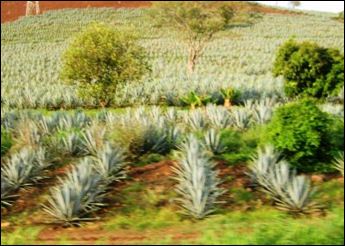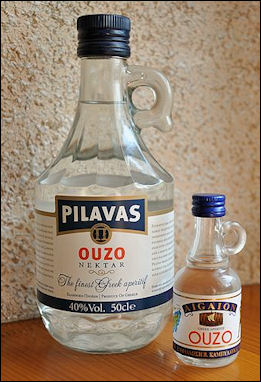GIN AND RUM
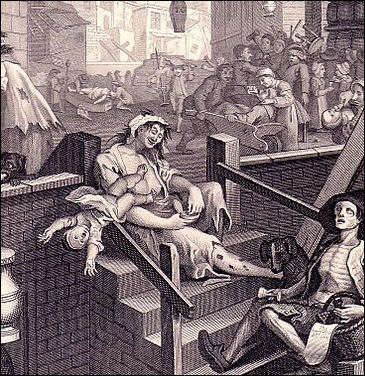
Hogarth's Gin Lane
Rum is made from sugar cane and is associated with the Caribbean. Jamaican rum is world famous. At the Wild Orge distillery in the Blue Mountains, Ian Sangster has won there gold medals in international competitions for his fine liqueurs which are made from a mixture of local rum, fruit and spices. According to one government survey the average Trinidadian consumes one rum drink a day. There are reportedly 47 different rum drinks available in Trinidad. They include passion fruit daiquiris, Golden Glows, Queen of Carnivals, and Bitter Ends.
Gin is a popular hard liquor drink, and one most associated Britain. Gin and tonics are one of the most famous mixed drinks. In the 18th and 19th centuries British expatriates in India and other tropical countries mixed in quinine with the drink as a preventative against malaria. The Gimlet, a mixture of lime juice and gin, was invented in 1890 by British naval surgeon who believed that drinking straight gin was unhealthy.
Gin is made from juniper berries of sloe berries. Holland first distilled a juniper-flavored alcohol called jenever. The French call it geniévre and the British shorten the drink's name to gin. In the early 1700's cheap gin flooded into working-class London, creating a low-life spectacle captured so vividly in William Hogarth's "Gin Lane." Today gin is regarded in Britain as a "stuffy old drink" for military officers and Tories. [Source: Boyd Gibbons, National Geographic, February 1992]
World’s Top Distilled Alcoholic Beverage Exporting Countries
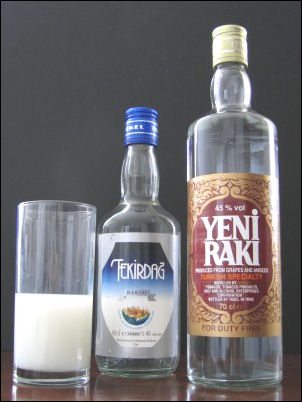
Raki
World’s Top Exporters of Distilled Alcoholic Beverages (2020): 1) United Kingdom: 970350 tonnes; 2) France: 389582 tonnes; 3) Italy: 334436 tonnes; 4) Mexico: 325447 tonnes; 5) United States: 229222 tonnes; 6) Netherlands: 212456 tonnes; 7) Germany: 201413 tonnes; 8) Canada: 187655 tonnes; 9) Spain: 173243 tonnes; 10) Ireland: 155180 tonnes; 11) Russia: 123838 tonnes; 12) Belgium: 122924 tonnes; 13) South Korea: 102000 tonnes; 14) Latvia: 99650 tonnes; 15) Sweden: 88619 tonnes; 16) Armenia: 84743 tonnes; 17) Poland: 69972 tonnes; 18) United Arab Emirates: 68576 tonnes; 19) India: 64952 tonnes; 20) Singapore: 56553 tonnes. [Source: FAOSTAT, Food and Agriculture Organization (U.N.), fao.org. A tonne (or metric ton) is a metric unit of mass equivalent to 1,000 kilograms (kgs) or 2,204.6 pounds (lbs). A ton is an imperial unit of mass equivalent to 1,016.047 kg or 2,240 lbs.]
World’s Top Exporters (in value terms) of Distilled Alcoholic Beverages (2020): 1) United Kingdom: US$6255002,000; 2) France: US$4525389,000; 3) Mexico: US$2407598,000; 4) United States: US$1932509,000; 5) Singapore: US$1757643,000; 6) Italy: US$1216036,000; 7) Ireland: US$1145072,000; 8) Germany: US$978269,000; 9) Netherlands: US$954722,000; 10) Spain: US$730166,000; 11) Latvia: US$598789,000; 12) Belgium: US$548861,000; 13) China: US$535011,000; 14) Canada: US$503175,000; 15) Sweden: US$421446,000; 16) Japan: US$375597,000; 17) Hong Kong: US$360397,000; 18) United Arab Emirates: US$241506,000; 19) Taiwan: US$241419,000; 20) Armenia: US$201814,000
World’s Top Distilled Alcoholic Beverage Importing Countries
World’s Top Importers of Distilled Alcoholic Beverages (2020): 1) United States: 792552 tonnes; 2) Germany: 316014 tonnes; 3) Russia: 284551 tonnes; 4) France: 236246 tonnes; 5) United Kingdom: 214373 tonnes; 6) Australia: 165505 tonnes; 7) Netherlands: 159212 tonnes; 8) Japan: 130223 tonnes; 9) Spain: 129884 tonnes; 10) China: 113442 tonnes; 11) Belgium: 97988 tonnes; 12) Italy: 96524 tonnes; 13) Latvia: 82923 tonnes; 14) Poland: 78064 tonnes; 15) Ukraine: 73530 tonnes; 16) Singapore: 70126 tonnes; 17) Mexico: 56907 tonnes; 18) Canada: 54549 tonnes; 19) Philippines: 53413 tonnes; w0) Chile: 50767 tonnes. [Source: FAOSTAT, Food and Agriculture Organization (U.N.), fao.org]
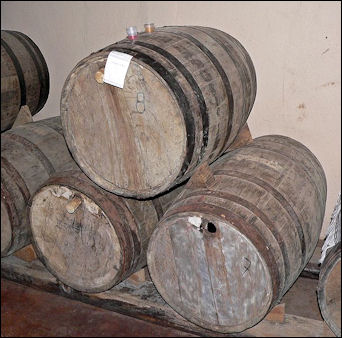
Tequila barrels World’s Top Importers (in value terms) of Distilled Alcoholic Beverages (2020): 1) United States: US$8901181,000; 2) China: US$1527513,000; 3) Germany: US$1513290,000; 4) Singapore: US$1468883,000; 5) France: US$1168108,000; 6) United Kingdom: US$980102,000; 7) Russia: US$971034,000; 8) Netherlands: US$918829,000; 9) Canada: US$898756,000; 10) Japan: US$674949,000; 11) Taiwan: US$665616,000; 12) Spain: US$637403,000; 13) Australia: US$620040,000; 14) Italy: US$603633,000; 15) Panama: US$512167,000; 16) Latvia: US$506448,000; 17) Hong Kong: US$444888,000; 18) Belgium: US$392188,000; 19) Poland: US$381652,000; 20) United Arab Emirates: US$284993,000
TEQUILA AND MESCAL
Tequila is an alcoholic drink made from the steamed hearts of the blue agave cactus produced in the Jalisco region of Mexico. The Nahuatl Indians believe that the agave cactus was a god and a means of communion with Mayahuel, a goddess with 400 breasts. The travel writer Paul Theroux wrote tequila has "more the wild-eyed giddiness of a narcotic drug than the giddiness of alcohol." Mescal and tequila both produce relatively mild hangovers.
Tequila is a multi-billion-dollar industry. The margarita, a cocktail ade is the most popular drink in United States, surpassing the gin an tonic, Bloody Mary and Rum and Coke.
All the world's tequila comes from the blue agave cactus grown near Jalsico, a small city in central Mexico near Guadalajara. Perhaps 200,000 are employed making the potent drink.
Mescal is similar to tequila but considered more exotic. It is made from the heart of a kind of agave cactus found in the southern mountainous Mexican state of Oaxaca. The cactus heart is baked in a rock pit, then fermented and distilled employing a centuries-old distilling process. Mescal distillers are small family owned businesses that produce only 10,000 cases of the precious liquid a year. Mescal is also famous the small worm at the bottom of the bottle that has traditionally been consumed in the last gulp from the bottle.
Making Tequila
agave cactus
Agave resembles a giant pineapple and it flowers rely on long-nosed bats to pollinate them. The first step in making tequila is stripping the plant of its long blade-like leaves and squeezing the plant to get the juice for tequila.
The process of tequila making beings with the harvest of the 100-pound pineapple-shape heart, the piña, with a few skilled swipes with a machete. One piña yields about six liters of tequila. Tequila factories go through tons of cactus hearts every day.
A liquid called an aquamiel is produced in the factory using different methods. Some simply squeeze the juice from the piña; others shred uncooked agave and feed the shoots into a pressure cooker-like devise.
After the tequila is distilled it is placed in giant oak casks. Full-flavored Reposa tequilas are placed for two months in casks line with banana leaves. Cognac-like Anejo tequilas are aged in the casks for five years or more. Gold tequilas are made from a mix of clear and aged tequilas. Some producers age the tequila in used Kentucky bourbon casks to give it a smoky flavor.
Tequilas are sometimes criticized for have a mass-produced industrial flavor. Cheap tequilas are about half distilled agave liquor and up to 49 percent alcohol made from cane or corn sugars.
Tequila Industry
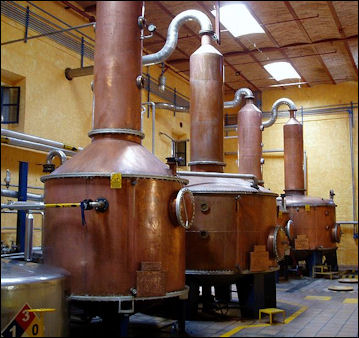
Copper tequila stills
Mexico's three major tequila producers are Cuervo, Sauza and Herradura. In 1995, the British-brewing giant Guinness purchased shares in all three companies. Each producer has its has its own production methods and carefully guards it recipes and doesn’t allow any photography in the factories.
In the 1960s the Cuervo and Sauza families feuded like the Hatfields and McCoys. In a salt and lemon version of Romeo and Juliet, one member of the Sauza was sent to the U.S. to attend a small university in Chicago. Who should he meet and fall in love with while he there but a relative of the Cuervo family. When the couple got married the young man's father cut off his allowance, forcing him to work as a tour guide in Mexico City to make ends meet. On his deathbed the father made up with his son and ever since then the Cuervos have dominated the tequila business. [Source: Bart McDowell, National Geographic, March 1967]
High-Brow Tequila and Mescal
In the United States tequila has long been associated with lemon, salt, fraternity parties and Panch Villao. In the mid-1990s, high-bow tequila that sold for as much as $100 a bottle began being marketed. More women started drinking it and joined men who swished it round in brandy snifter and enjoyed it with a Cuban cigar. Sales of Portidio premium tequila, for example, doubled between 1995 to 1996 to almost 20 million liters.
Martin Grassi, an Austrian involved in the premium tequila business, told Reuters, "Those people who used to drink margaritas with cheap tequila in their college days are now grown-up yuppies in New York. That is who id drinking Portifidio."
Tequila expert James D. Gollin wrote in the New York Times, "Young tequilas are generally cheap and rougher than the anejos while 100 percent agave tequilas have a more pronounced flavor." A bottle of dark, woody Reserva del Familia, contains tequilas up to a 100 years old and sells for $200 a bottle.
Upscale versions of mescal have also been introduced. Fans of the drink say that tastes range from herbal and smoky to fruity and spicy. One aficionado told Newsweek, "It's as complex as any of the single-malt Scotches I've had, and it's a lot more exotic." Glasses of Encantado Mesqual sell for $7 a glass at fine restaurants in California. Bottles of Encantado sel for $40 a pop.
Salt and Lime and Margaritas
.png)
tequila-producing areas of Mexico
The traditional way to drinking tequila is place some salt on the back of the hand, then lick it and gulp down a shot of tequila followed by and bite into a a slice of lime or lemon. The custom originated in Mexico and was practiced by Pancho Villa, who also reportedly smoked cannabis. The days in Mexico many people like to drink tequila and grapefruit juice over ice. It also often drunk straight with a beer chaser.
Tequila is often mixed with fruit and severed in cocktails like tequila sunrises, Margaritas or tequila sours. To make a margarita you need to mix two parts gold tequila, two parts freshly squeezed lime juice, one part triple sec and shake it vigorously with crushed ice and then pour it into a glass with a lightly salted rim. To get the salt to stick rub the spent lime around the edge of the glass.
There are many stories about the origin of the Margarita. In one of th more famous ones, a Mexican colonel asked a bartender to salt his glass and squeeze fresh lime into his tequila, instead of biting the lime and licking the salt in the traditional way, so the could keep his eyes on a voluptuous dancer named Margarita.
Other tequila drinks include the tequila "Muppet" or "popper," made with tequila shaken up with Seven-Up, and the Sangrita, tequila mixed with tomato juice, orange juice, Maguey sauce and chile peppers. Strawberry, lemon-lime and mango margaritas are sipped from salt-rimmed glasses. Mexicans also use tequila as a medicine, after-shave lotion, meat tenderizer and aphrodisiac. It is used as an astringent on cuts and contusions as well as a fuel for lighting charcoal fires.
Raki and Ouzo
Ouzo
The beverage of choice in Turkey is rakı, or raki, a licorice flavored drink similar to Greek ouzo, Italian grappa or anisette. Raki is very strong (45 percent alcohol) and when it mixed with ice and water — the most common way of drinking it — it turns from a clear liquid into a milky white one. The Turks drink rakı at most social gathering and they prefer to drink it with food, preferably fish, seafood or tapa-like mezes, to lessen the likelihood of a hangover.
In Greece ouzo is often consumed with dried fish or octopus. To this day, Turks and Greeks have bitter arguments as to which is better, raki or ouzo. The Turks claim raki is superior because making it is more complex. It is distilled twice in traditional copper vats, one using the concentrate made from seedless grapes and the other from a special kind of anise.
Raki has been called “gloriously unique” and a “distillation of the Turkish soul.” One Turk told the New York Times, “Raki civilizes society. That’s very important here, because Turkey is such a huge mess that if I didn’t have something like raki, we’d probably become hopeless and all commit suicide.”
There are three grades of raki: 1) “altinbas”, the premium grade made with fermented grapes only; 2) “kulup” , the medium grade made with lower-quality fermented grapes only; and 3) “yeni raki”, the lowest grade, made partly with pure alcohol. Many Turks say that Yeni raki is the best. Tekel, the Turkish government’s cigarette and alcohol monopoly, is the only legal producer of raki. The price is relatively low, around $5 a bottle, so there is little incentive for bootleggers.
History of Raki
Raki production dates back to the 17th century. There is no tradition of drinking it or a similar drink in Central Asia where the Turks come from thus it can be fair to deduce that they likely appropriated the drink from one its Mediterranean neighbors, notably the Greeks, which have a history of drinking it before the 17th century. [Source: Stephen Kinzer, New York Times, June 28, 2000]
Ataturk was a big raki drinker. Raki destroyed his liver and caused his early death. According to one story, Ataturk once asked a dinner guest what goes best with raki. They guest replied “leblebi” [a chick pea dish].” “Wrong,” Ataturk replied. “The best accompaniment to raki is good conversation.”
Ataturk, who was born in what is now Greece, is also credited with making the drink popular in Turkey. A raki company manager told the New York Times, “When the Republic was founded, most members of Parliament were very conservative religious figures, and alcohol was illegal. Ataturk used to serve it to his friends at home. They would say to him, “Pasha, it’s great that we can drink when we’re with you, but why don’t you make raki legal so we can drink it in our homes? That made sense to him, and after a while the ban was lifted.”

Types of ouzo
During the 1950s and 60s, interest in raki decreased among Istanbulers who began regarding it as an unsophisticated drink of country bumpkin. They began drinking wine and whiskey. This fashion didn’t long. Raki is now regarded as the national drink and Turks are proud to say that is so.
Raki Drinking
Raki is usually consumed in a tall glass. The glass is filed about one third with raki. Water is then poured in. The translucent white color that results is the source of raki’s nickname — lion’s milk. Sometimes ice is added.
One Turk told the New York Times, “You have to drink it like a gentleman, which of course means never drinking too much. All the senses are involved. First you watch the water being poured into the glass and mixing with raki. Then, you pick up the glass and inhale the aroma. When you drink it, you take a small sip, feel the pleasure of it flowing down your throat, take another small sip, then put the glass down...The best part is feeling it go down your throat. A giraffe — that’s an animal ideally made to appreciate raki.”
Raki drinking is mainly a male thing. A Turkish doctor told the New York Times, “A lot of foreign women who live in Turkey develop a taste for it, but not many Turkish women don’t. You’ll see 6 or 8 or 10 or 20 guys sitting around a table drinking without a woman in sight.”

Various tequila
Image Sources: Wikimedia Commons
Text Sources: National Geographic, New York Times, Washington Post, Los Angeles Times, Smithsonian magazine, Natural History magazine, Discover magazine, Times of London, The New Yorker, Time, Newsweek, Reuters, AP, AFP, Lonely Planet Guides, Compton’s Encyclopedia and various books and other publications.
Last updated March 2022

